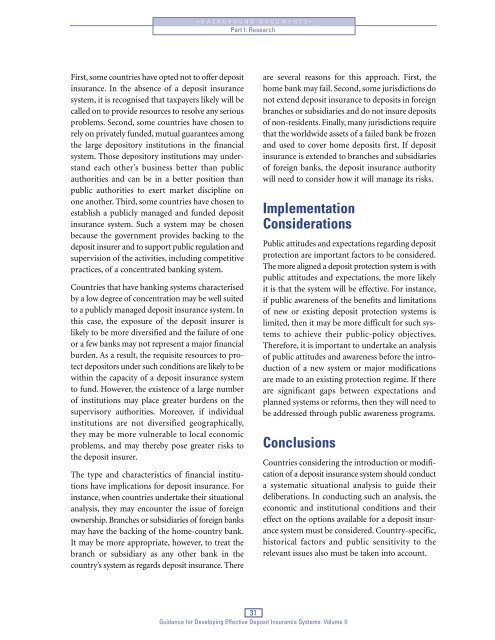Volume II - PDF - International Association of Deposit Insurers
Volume II - PDF - International Association of Deposit Insurers
Volume II - PDF - International Association of Deposit Insurers
- No tags were found...
Create successful ePaper yourself
Turn your PDF publications into a flip-book with our unique Google optimized e-Paper software.
•BACKGROUND DOCUMENTS•<br />
Part I: Research<br />
First, some countries have opted not to <strong>of</strong>fer deposit<br />
insurance. In the absence <strong>of</strong> a deposit insurance<br />
system, it is recognised that taxpayers likely will be<br />
called on to provide resources to resolve any serious<br />
problems. Second, some countries have chosen to<br />
rely on privately funded, mutual guarantees among<br />
the large depository institutions in the financial<br />
system. Those depository institutions may understand<br />
each other’s business better than public<br />
authorities and can be in a better position than<br />
public authorities to exert market discipline on<br />
one another. Third, some countries have chosen to<br />
establish a publicly managed and funded deposit<br />
insurance system. Such a system may be chosen<br />
because the government provides backing to the<br />
deposit insurer and to support public regulation and<br />
supervision <strong>of</strong> the activities, including competitive<br />
practices, <strong>of</strong> a concentrated banking system.<br />
Countries that have banking systems characterised<br />
by a low degree <strong>of</strong> concentration may be well suited<br />
to a publicly managed deposit insurance system. In<br />
this case, the exposure <strong>of</strong> the deposit insurer is<br />
likely to be more diversified and the failure <strong>of</strong> one<br />
or a few banks may not represent a major financial<br />
burden. As a result, the requisite resources to protect<br />
depositors under such conditions are likely to be<br />
within the capacity <strong>of</strong> a deposit insurance system<br />
to fund. However, the existence <strong>of</strong> a large number<br />
<strong>of</strong> institutions may place greater burdens on the<br />
supervisory authorities. Moreover, if individual<br />
institutions are not diversified geographically,<br />
they may be more vulnerable to local economic<br />
problems, and may thereby pose greater risks to<br />
the deposit insurer.<br />
The type and characteristics <strong>of</strong> financial institutions<br />
have implications for deposit insurance. For<br />
instance, when countries undertake their situational<br />
analysis, they may encounter the issue <strong>of</strong> foreign<br />
ownership. Branches or subsidiaries <strong>of</strong> foreign banks<br />
may have the backing <strong>of</strong> the home-country bank.<br />
It may be more appropriate, however, to treat the<br />
branch or subsidiary as any other bank in the<br />
country’s system as regards deposit insurance. There<br />
are several reasons for this approach. First, the<br />
home bank may fail. Second, some jurisdictions do<br />
not extend deposit insurance to deposits in foreign<br />
branches or subsidiaries and do not insure deposits<br />
<strong>of</strong> non-residents. Finally, many jurisdictions require<br />
that the worldwide assets <strong>of</strong> a failed bank be frozen<br />
and used to cover home deposits first. If deposit<br />
insurance is extended to branches and subsidiaries<br />
<strong>of</strong> foreign banks, the deposit insurance authority<br />
will need to consider how it will manage its risks.<br />
Implementation<br />
Considerations<br />
Public attitudes and expectations regarding deposit<br />
protection are important factors to be considered.<br />
The more aligned a deposit protection system is with<br />
public attitudes and expectations, the more likely<br />
it is that the system will be effective. For instance,<br />
if public awareness <strong>of</strong> the benefits and limitations<br />
<strong>of</strong> new or existing deposit protection systems is<br />
limited, then it may be more difficult for such systems<br />
to achieve their public-policy objectives.<br />
Therefore, it is important to undertake an analysis<br />
<strong>of</strong> public attitudes and awareness before the introduction<br />
<strong>of</strong> a new system or major modifications<br />
are made to an existing protection regime. If there<br />
are significant gaps between expectations and<br />
planned systems or reforms, then they will need to<br />
be addressed through public awareness programs.<br />
Conclusions<br />
Countries considering the introduction or modification<br />
<strong>of</strong> a deposit insurance system should conduct<br />
a systematic situational analysis to guide their<br />
deliberations. In conducting such an analysis, the<br />
economic and institutional conditions and their<br />
effect on the options available for a deposit insurance<br />
system must be considered. Country-specific,<br />
historical factors and public sensitivity to the<br />
relevant issues also must be taken into account.<br />
31<br />
Guidance for Developing Effective <strong>Deposit</strong> Insurance Systems: <strong>Volume</strong> <strong>II</strong>
















